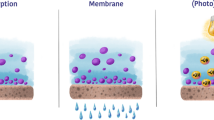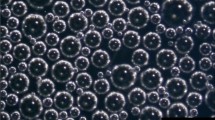Abstract
Porous geopolymers (GP) are energy saving, environment-friendly and simple in preparation, which has attracted increasing attention from both academia and industry. In this paper, geopolymer with excellent immobilization capability of heavy metals was prepared by chemical forming method. The spent fluid catalytic cracking (sFCC) catalyst, a hazardous solid waste in China, was exploited as aluminosilicate precursor. The influences of particle size of sFCC catalyst, type of activator agent solutions, mass ratios of SiO2/Na2O and (SiO2 + Na2O)/sFCC catalyst on the compressive strength of GP and the leaching toxicity of Ni were investigated in detail. Under the optimum conditions, the leaching toxicity of Ni is reduced to below 0.01 ppm, much lower than the national standard 5 ppm. The as-obtained GP was also examined by SEM, XRD and FTIR with the aim to understand the synthesis and immobilization mechanism using the sFCC catalyst as the raw material. The results show a new aluminosilicate zoisite phase with three-dimensional network structure forms. Ni element enters the grid of GP, involved in the formation of three-dimensional network structure. Besides, partial Ni element replaces the position of alkaline metal and chemical bonds AlO4.






Similar content being viewed by others
References
Font A, Borrachero MV, Soriano L, Monzó J, Payá J (2017) Geopolymer eco-cellular concrete (GECC) based on fluid catalytic cracking catalyst residue (FCC) with addition of recycled aluminium foil powder. J Clean Prod 168:1120–1131
Zhang D, Wen B, Chen Y, Xu Q, Zhu X, Sun N, Liu X, Yin D (2020) Reuse of waste catalytic-cracking catalyst: fine performance in acetalization. J Mater Cycles Waste Manag 22:22–29
Basaldella EI, Paladino JC, Solari M, Valle GM (2006) Exhausted fluid catalytic cracking catalysts as raw materials for zeolite synthesis. Appl Catal B Environ 66:186–191
Bayraktar O (2005) Bioleaching of nickel from equilibrium fluid catalytic cracking catalysts. World J Microbiol Biotechnol 21:661–665
Innocenzi V, Ferella F, De Michelis I, Veglio F (2015) Treatment of fluid catalytic cracking spent catalysts to recover lanthanum and cerium: comparison between selective precipitation and solvent extraction. J Ind Eng Chem 24:92–97
Reed DW, Fujita Y, Daubaras AL, Jiao Y, Thompson VS (2016) Bioleaching of rare earth elements from waste phosphors and cracking catalysts. Hydrometallurgy 166:34–40
Rodriguez ED, Bernal SA, Provis JL, Gehman JD, Monzo JM, Paya J, Borrachero MV (2013) Geopolymers based on spent catalyst residue from a fluid catalytic cracking (FCC) process. Fuel 109:493–502
Busca G, Riani P, Garbarino G, Ziemacki G, Gambino L, Montanari E, Millini R (2014) The state of nickel in spent fluid catalytic cracking catalysts. Appl Catal A Gen 486:176–186
Guo B, Liu B, Yang J, Zhang S (2017) The mechanisms of heavy metal immobilization by cementitious material treatments and thermal treatments: a review. J Environ Manag 193:410–422
Al-Jabri K, Baawain M, Taha R, Al-Kamyani ZS, Al-Shamsi K, Ishtieh A (2013) Potential use of FCC spent catalyst as partial replacement of cement or sand in cement mortars. Constr Build Mater 39:77–81
Soriano L, Paya J, Monzo J, Borrachero MV, Tashima MM (2016) High strength mortars using ordinary Portland cement-fly ash-fluid catalytic cracking catalyst residue ternary system (OPC/FA/FCC). Constr Build Mater 106:228–235
Tashima MM, Akasaki JL, Melges JLP, Soriano L, Monzo J, Paya J, Borrachero MV (2013) Alkali activated materials based on fluid catalytic cracking catalyst residue (FCC): influence of SiO2/Na2O and H2O/FCC ratio on mechanical strength and microstructure. Fuel 108:833–839
Komnitsas K, Zaharaki D (2007) Geopolymerisation: a review and prospects for the minerals industry. Miner Eng 20:1261–1277
Chen X, Niu Z, Wang J, Zhu GR, Zhou M (2018) Effect of sodium polyacrylate on mechanical properties and microstructure of metakaolin-based geopolymer with different SiO2/Al2O3 ratio. Ceram Int 44:18173–18180
Santa R, Soares C, Riella HG (2016) Geopolymers with a high percentage of bottom ash for solidification/immobilization of different toxic metals. J Hazard Mater 318:145–153
El-Eswed BI, Yousef RI, Alshaaer M, Hamadneh I, Al-Gharabli SI, Khalili F (2015) Stabilization/solidification of heavy metals in kaolin/zeolite based geopolymers. Int J Miner Process 137:34–42
Zhang YS, Sun W, Chen QL, Chen L (2007) Synthesis and heavy metal immobilization behaviors of slag based geopolymer. J Hazard Mater 143:206–213
Zhang JG, Provis JL, Feng DW, van Deventer JSJ (2008) Geopolymers for immobilization of Cr6+, Cd2+, and Pb2+. J Hazard Mater 157:587–598
Tashima MM, Akasaki JL, Castaldelli VN, Soriano L, Monzo J, Paya J, Borrachero MV (2012) New geopolymeric binder based on fluid catalytic cracking catalyst residue (FCC). Mater Lett 80:50–52
Ul Haq E, Padmanabhan SK, Licciulli A (2015) Microwave synthesis of thermal insulating foams from coal derived bottom ash. Fuel Process Technol 130:263–267
Al-Degs YS, Ghrir A, Khoury H, Walker GM, Sunjuk M, Al-Ghouti MA (2014) Characterization and utilization of fly ash of heavy fuel oil generated in power stations. Fuel Process Technol 123:41–46
Trochez JJ, de Gutierrez RM, Rivera J, Bernal SA (2015) Synthesis of geopolymer from spent FCC: effect of SiO2/Al2O3 and Na2O/SiO2 molar ratios. Mater De Construccion 65:11
Hajimohammadi A, van Deventer JSJ (2016) Dissolution behaviour of source materials for synthesis of geopolymer binders: a kinetic approach. Int J Miner Process 153:80–86
Rodríguez ED, Bernal SA, Provis JL, Gehman JD, Monzó JM, Jordi Payá M, Borrachero V (2013) Geopolymers based on spent catalyst residue from a fluid catalytic cracking (FCC) process. Fuel 109:493–502
Payá J, Monzó J, Borrachero MV, Velázquez S, Bonilla M (2003) Determination of the pozzolanic activity of fluid catalytic cracking residue. Thermogravimetric analysis studies on FC3R–lime pastes. Cem Concr Res 33:1085–1091
Phair JW, Van Deventer JSJ (2002) Effect of the silicate activator pH on the microstructural characteristics of waste-based geopolymers. Int J Miner Process 66:121–143
Duxson P, Fernandez-Jimenez A, Provis JL, Lukey GC, Palomo A, van Deventer JSJ (2007) Geopolymer technology: the current state of the art. J Mater Sci 42:2917–2933
Deja J (2002) Immobilization of Cr6+, Cd2+, Zn2+ and Pb2+ in alkali-activated slag binders. Cem Concr Res 32:1971–1979
Zhang YS, Sun W, She W, Sun GW (2009) Synthesis and heavy metal immobilization behaviors of fly ash based geopolymer. J Wuhan Univ Technol Mater Sci Ed 24:819–825
Prud’homme E, Michaud P, Joussein E, Peyratout C, Smith A, Arrii-Clacens S, Clacens JM, Rossignol S (2010) Silica fume as porogent agent in geo-materials at low temperature. J Eur Ceram Soc 30(7):1641–1648
Leiva C, Luna-Galiano Y, Arenas C, Alonso-Fariñas B, Fernández-Pereira C (2019) A porous geopolymer based on aluminum-waste with acoustic properties. Waste Manag 95:504–512
Acknowledgements
This study was financially supported by the National Key R&D Program of China (No. 2018YFC1803300) and SINOPEC
Author information
Authors and Affiliations
Corresponding author
Additional information
Publisher's Note
Springer Nature remains neutral with regard to jurisdictional claims in published maps and institutional affiliations.
Supplementary Information
Below is the link to the electronic supplementary material.
Rights and permissions
About this article
Cite this article
Zhang, HZ., Fang, SP., Liu, ZW. et al. Geopolymer synthesized from spent fluid catalytic cracking catalyst and its heavy metal immobilization behavior. J Mater Cycles Waste Manag 23, 976–984 (2021). https://doi.org/10.1007/s10163-021-01185-9
Received:
Accepted:
Published:
Issue Date:
DOI: https://doi.org/10.1007/s10163-021-01185-9




